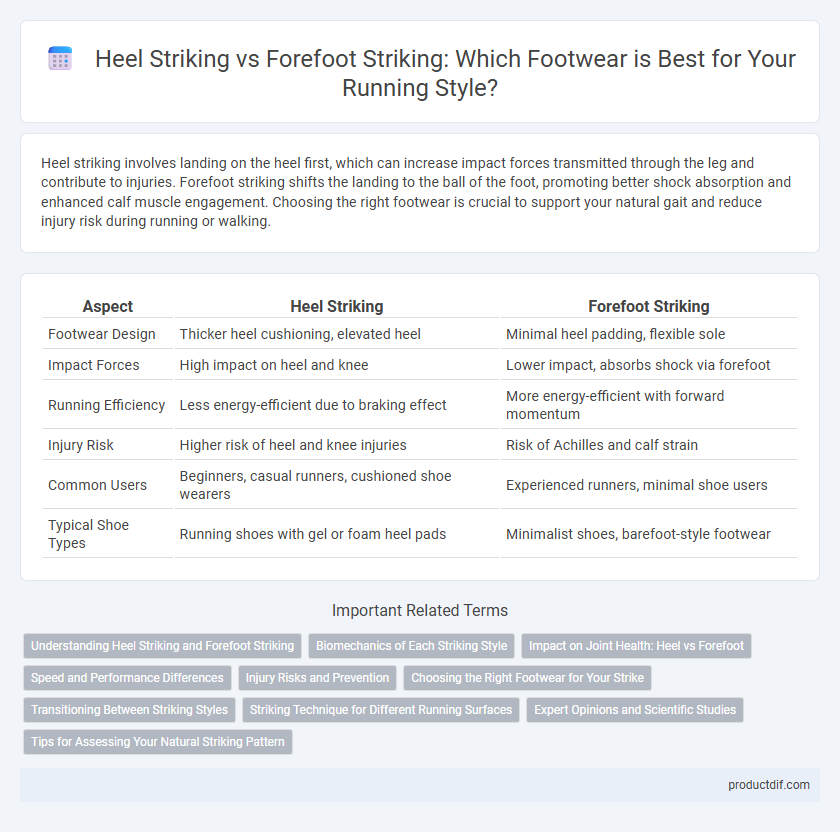Heel striking involves landing on the heel first, which can increase impact forces transmitted through the leg and contribute to injuries. Forefoot striking shifts the landing to the ball of the foot, promoting better shock absorption and enhanced calf muscle engagement. Choosing the right footwear is crucial to support your natural gait and reduce injury risk during running or walking.
Table of Comparison
| Aspect | Heel Striking | Forefoot Striking |
|---|---|---|
| Footwear Design | Thicker heel cushioning, elevated heel | Minimal heel padding, flexible sole |
| Impact Forces | High impact on heel and knee | Lower impact, absorbs shock via forefoot |
| Running Efficiency | Less energy-efficient due to braking effect | More energy-efficient with forward momentum |
| Injury Risk | Higher risk of heel and knee injuries | Risk of Achilles and calf strain |
| Common Users | Beginners, casual runners, cushioned shoe wearers | Experienced runners, minimal shoe users |
| Typical Shoe Types | Running shoes with gel or foam heel pads | Minimalist shoes, barefoot-style footwear |
Understanding Heel Striking and Forefoot Striking
Heel striking occurs when the heel of the foot makes initial contact with the ground during running, often causing higher impact forces and potential stress on the knees. Forefoot striking involves landing on the ball of the foot, which promotes a more natural shock absorption through the ankle and calf muscles. Understanding these striking patterns helps in selecting appropriate footwear that supports foot biomechanics and reduces injury risks.
Biomechanics of Each Striking Style
Heel striking involves initial ground contact with the heel, producing a rapid deceleration force that generates higher impact transients and increased loading rates on the heel and knee joints. Forefoot striking shifts ground contact to the ball of the foot, enhancing shock absorption through ankle plantarflexion and promoting a more elastic energy return via the Achilles tendon. Biomechanically, forefoot striking reduces braking forces and may lower the risk of certain overuse injuries by altering joint angles and muscle activation patterns compared to heel striking.
Impact on Joint Health: Heel vs Forefoot
Heel striking generates greater impact forces on the knees and hips due to increased ground reaction forces, often leading to higher joint stress and potential injury over time. Forefoot striking reduces shock absorption at the knee by distributing forces more evenly through the ankle and calf muscles, which can lower the risk of joint degeneration. Choosing between heel and forefoot striking significantly influences long-term joint health and injury prevention in footwear biomechanics.
Speed and Performance Differences
Forefoot striking generally enhances speed and performance by promoting a more efficient running form that reduces ground contact time and increases stride frequency. Heel striking often results in greater impact forces and slower cadence, which can limit acceleration and overall running velocity. Research indicates forefoot striking improves elastic energy storage in the Achilles tendon, contributing to faster propulsion and improved running economy.
Injury Risks and Prevention
Heel striking often leads to higher impact forces transmitted through the knees and hips, increasing the risk of stress fractures and joint pain. Forefoot striking reduces impact severity by promoting better shock absorption through the ankle and calf muscles, which can help prevent common injuries such as plantar fasciitis and Achilles tendinopathy. Proper footwear with adequate cushioning and support tailored to the striking pattern is essential for injury prevention.
Choosing the Right Footwear for Your Strike
Choosing the right footwear for heel striking involves selecting shoes with ample cushioning and shock absorption in the heel area to reduce impact forces and prevent injuries. Forefoot strikers benefit from shoes with flexible soles and enhanced forefoot support that promote natural foot movement and improve propulsion. Understanding your strike pattern ensures optimal comfort, performance, and injury prevention by matching shoe design features with your foot's biomechanics.
Transitioning Between Striking Styles
Transitioning between heel striking and forefoot striking requires a gradual adaptation period to prevent injury, as forefoot striking places more stress on the calf muscles and Achilles tendon. Incorporating strength training and flexibility exercises can support the biomechanical changes necessary for an efficient gait. Proper footwear with adequate cushioning and arch support further facilitates this transition, reducing impact forces and enhancing stability during the adjustment phase.
Striking Technique for Different Running Surfaces
Heel striking on hard surfaces like concrete can increase impact forces, leading to higher risk of joint stress and injury. Forefoot striking distributes impact more evenly, enhancing shock absorption on softer surfaces such as trails or grass. Selecting the appropriate striking technique tailored to running surface conditions improves performance and reduces injury risk.
Expert Opinions and Scientific Studies
Expert opinions and scientific studies highlight significant differences between heel striking and forefoot striking in running biomechanics. Research indicates that heel striking often generates higher impact forces, potentially increasing the risk of injuries such as stress fractures and joint problems, while forefoot striking promotes better shock absorption and may reduce injury rates by engaging the calf muscles and Achilles tendon more effectively. Studies also suggest that forefoot striking improves running economy by enhancing elastic energy storage and release, though the best strike pattern can vary depending on individual biomechanics and running goals.
Tips for Assessing Your Natural Striking Pattern
To assess your natural striking pattern, record a video of your feet while running on a treadmill at a comfortable pace, then analyze which part of the foot contacts the ground first. Observe your footfall: heel strikers land on the rear, potentially absorbing impact with the heel, while forefoot strikers engage the ball of the foot, promoting a springier gait. Wear patterns on your running shoes also serve as clues--heel wear indicates heel striking, whereas more wear near the toes suggests forefoot striking.
Heel striking vs Forefoot striking Infographic

 productdif.com
productdif.com